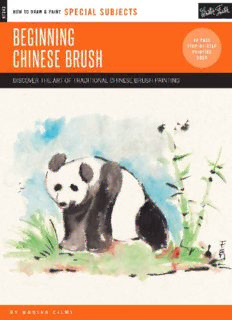
Special Subjects: Beginning Chinese Brush: Discover the Art of Traditional Chinese Brush Painting PDF
Preview Special Subjects: Beginning Chinese Brush: Discover the Art of Traditional Chinese Brush Painting
BEGINNING CHINESE BRUSH Chinese brushwork is an ancient art form that developed hundreds of years ago in China and is now very popular with artists all over the world. It captures the essence of nature and expresses the feelings of the artist. The animal and flower subjects symbolize good fortune, good luck, wisdom, renewal, purity, and more. In Chinese brush painting, each brushstroke has its own spirit and moves in that moment; it cannot be improved or corrected. Rather than sketch or outline, the artist holds the subject in mind and transforms that image into reality using quick and instinctive strokes. To the artist, the whole painting becomes part of the subject itself and, therefore, part of nature. —Monika Cilmi CONTENTS Tools & Materials Getting Started Shape and Contour Adding Color Practicing Brushstrokes Playing with Hues Capturing Patterns Creating a Composition Building Texture Rendering Foliage Using Large Strokes Painting with Nuance Enriching Detail Focal Point TOOLS & MATERIALS The materials used for Chinese brush painting are called the Four Treasures: brush, paper, ink, and ink stone. BRUSHES Chinese brushes are made of animal hair glued into a bamboo handle. New brushes are stiffened to protect the fibers. Brushes contain either a single type of hair or a mixture of two or three hair types. Goat-hair brushes are very common and easy to find. Goat-, squirrel-, and rabbit-hair brushes are used for soft strokes (in paintings of animals, flowers, and fruit), and brushes made of wolf, badger, and horse hair are common for landscape work. TIP Before using your brushes for the first time, soak them in water. Once dry, store them upside down on a Chinese brush holder (available in different shapes and styles) or in a normal pen or brush holder. PAPER The most common Chinese paper used for Chinese brush painting is Xuan. Known in Western countries as rice paper, it is very absorbent and strong. Other papers, such as grass paper and mulberry paper, are available in sheets and rolls. As a beginner, try painting on different types to learn their absorbency and general quality. INK Ink comes in stick and liquid form. An ink stick is made from charcoal or charcoal soot mixed with glues and oils. Ink sticks can be decorated, and the older the ink stick, the better the ink quality. Good- quality ink produces smooth and even tones. Although liquid ink is less expensive, it does not give the same tonality control as the ground stick ink. INK STONE Use the ink stone, which is made from carved stone or slate, to grind the ink stick. Ink stones come in different shapes, and the best is the Duan from South China. It is a good idea to start with a traditional rectangular or round stone (which is less expensive) to learn how to grind the ink. Find ink stones in various online shops. TIP When it comes to ink stones, quality is important. A rough stone will not produce good ink.
Description: